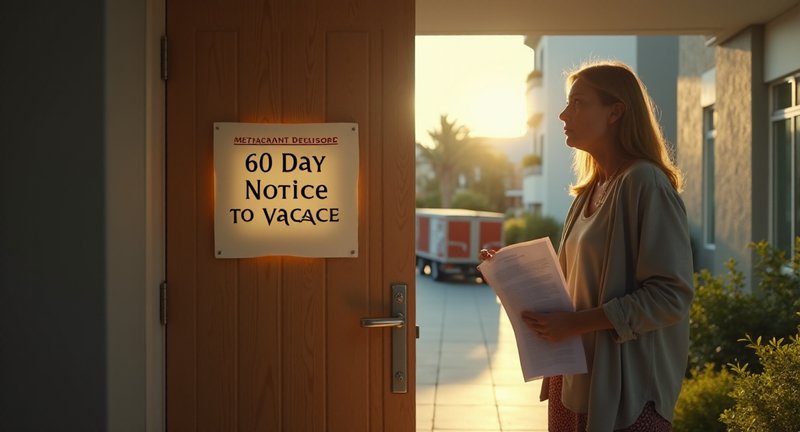60 Day Notice to Vacate California
Considering moving out of a rental in California, there’s a particular step you shouldn’t overlook: the ‘.’ If you’re unfamiliar with this, let me break it down from my own experience. This notice isn’t just a courtesy; it’s a legal requirement for most tenants who’ve lived in their place for a year or more. Trust me, skipping this can lead to a world of complications.
I remember when I had to send mine. The process felt straightforward, but there were hidden nuances. The ” isn’t something you can just scribble on a sticky note and leave on your landlord’s door. It needs to be formal, properly dated, and clear about your intentions to vacate the property by the specified date. It’s all about the right wording, otherwise, you could end up extending your stay longer than you planned.

You might ask: why 60 days? In California, that’s the standard if you’ve been around a while in your rental. It gives both the tenant and landlord time to prepare for the transition. From my own move, I can tell you, planning ahead made everything smoother. Two months gave me time to pack, tie up loose ends, and even find a new place without rushing.
So, if you’re facing a move, don’t wait until the last minute. Get that ” ready and avoid unnecessary headaches. It’s one of those small but crucial details that can make all the difference when you’re moving out.
The Importance of 60 Day Notice to Vacate California
From personal experience, navigating tenant-landlord relationships in California comes with its own unique set of challenges. One of the key pieces of the puzzle is providing the right amount of notice when it’s time to move out. Trust me, whether you’re a landlord or tenant, timing matters and it’s not just about common courtesy. Here’s why getting this process right can save you some major headaches.
First, there’s a legal requirement to give ample time. In many cases, this timeframe is around two months. If you’re planning on moving, providing enough notice ensures you’re not blindsided by unexpected fees or penalties. On the landlord side, it allows for proper planning to find new tenants without creating a gap in income.

Here’s what I’ve found most important to keep in mind:
- Plan ahead: If you think moving is in your near future, mark a date on your calendar as soon as possible. This way, you won’t forget to notify in time.
- Check your lease agreement: Every lease has its own nuances, so it’s worth double-checking what’s expected before you send in that notice.
- Document everything: Always give notice in writing. An email works, but having a hard copy sent via certified mail can protect you from any future disputes.
Being prepared and informed can prevent legal disputes, ensure smooth transitions, and save both parties time, money, and stress. If there’s one thing I’ve learned, it’s that giving enough notice is not just a formality it’s essential for both sides to feel secure.
Understanding the Importance of a 60 Day Notice in California
Let’s dive into a topic that might seem mundane but holds significant power in the world of California real estate: the 60-day notice. You might wonder, why exactly is this timeframe so crucial? Well, it’s all about striking the right balance between the rights of property owners and the needs of tenants. For landlords, this notice is a safeguard a way to prepare for a transition, whether it’s refurbishing the property, finding a new tenant, or even putting the property on the market. For tenants, it provides a reasonable window to find a new place, pack up their lives, and move on without feeling rushed.
In my experience, this notice period can make or break the moving process. When handled correctly, it can lead to a smooth transition for both parties. However, it’s not just a simple ‘heads up’ but a legal requirement that comes with its own set of rules. Here are some key points to remember:
- Timing is everything: The 60-day countdown starts the day after the notice is served. It’s not retroactive, so mark your calendars.
- Delivery matters: The notice must be delivered in a way that’s legally acceptable, which usually means in person, via certified mail, or sometimes, posted on the property.
- Exceptions exist: Not all situations require a full 60-day notice. For example, if a tenant has lived in the property for less than a year, a 30-day notice might be sufficient.
The key takeaway here is that this notice isn’t just a formality; it’s a structured process designed to protect both sides. So, whether you’re a tenant or a landlord, understanding this concept can save you from potential headaches.
Key Legal Requirements for Giving Notice to End Tenancy
In my experience, ending a tenancy isn’t as simple as packing up and saying goodbye. There are several legal hoops you need to jump through, and missing any of them can land you in hot water. So, let’s talk about the crucial legal requirements you should be aware of when giving notice to end a tenancy.
First, timing is everything. The amount of notice you’re required to give varies depending on the type of tenancy and how long the tenant has lived in the property. It’s not a one-size-fits-all situation. For instance, if someone’s been around for a while, the law might demand more than just a quick heads-up.
Next, delivery of notice isn’t something to take lightly. You can’t just leave a note on the fridge and call it a day. The law often requires the notice to be delivered in a specific way, like sending it via certified mail or handing it over in person. Trust me, this small detail can make or break your case if things get messy.
Then, there’s the reason for termination. Some jurisdictions require you to have a “just cause” for ending the lease, especially when rent control laws are in place. A casual ‘I feel like it’ won’t cut it in those cases. You must align your reasons with what the law allows.
As a matter of fact, understanding the tenant’s rights is key. Tenants are often protected by various regulations, and failing to respect those could lead to costly disputes. Always double-check local laws before making your move.
Who Needs to Provide a 60 Day Notice in California?
In California, knowing who needs to give a heads-up for a move is crucial, especially when you’re juggling a rental or business property. Based on my own experience, it’s not always straightforward. Some folks assume they can just pack up and leave whenever they please, but that’s not the case here. The state has specific requirements for tenants and landlords alike.
So, who exactly needs to provide notice?
-
Landlords: If you’re a property owner looking to end a month-to-month tenancy, the law mandates you to inform your tenant at least 60 days in advance. This is particularly the case if the tenant has been renting for more than a year.
-
Tenants: For renters, if you’ve been in a place for over 12 months and you’re on a month-to-month lease, you’re on the hook to give your landlord the same 60-day heads-up if you’re planning to leave. Anything less, and you might be staring down some penalties.
But, of course, there are exceptions. For instance, if you’re the tenant and you’ve been living there for less than a year, you typically only need to give a 30-day notice. It’s a detail often overlooked until it’s time to move and believe me it’s the last thing you want to be caught unprepared for.
And don’t forget: There’s also special protection for people in rent-controlled areas or facing eviction for reasons beyond their control. It’s essential to check your local rules because not everything is cut and dry.
Bottom line: Whether you’re a tenant or a landlord, a little planning and knowing the rules can save you from headaches later.
Reasons to Give a Notice of Intent to Vacate
When it comes time to move on from your rental, giving a proper notice of intent to vacate is more than just a formality it’s an essential step that helps ensure a smooth transition. From my own experience, here’s why it’s crucial to submit this notice thoughtfully:
-
Maintaining Good Relations: By providing advance notice, you demonstrate respect and professionalism. It keeps the landlord informed, allowing them ample time to find new tenants and prepare for your departure. This can be invaluable if you need a positive reference in the future.
-
Avoiding Penalties: Many leases stipulate a specific notice period. Failing to adhere to these requirements can result in financial penalties or the forfeiture of your security deposit. By giving notice according to the lease terms, you safeguard yourself from potential disputes and extra charges.
-
Ensuring Proper Handover: Early notice gives you time to address any necessary repairs or cleaning before you leave. It also ensures that you can schedule a move-out inspection with your landlord, which can help in getting your deposit back in full.
-
Planning Your Next Steps: Moving can be chaotic, so a timely notice helps you organize your next steps. Whether it’s coordinating with movers or finalizing arrangements for your new place, having a clear timeline reduces stress and makes the process smoother.
-
Legal and Contractual Obligations: From a legal standpoint, providing notice is often a contractual obligation. Ensuring that you fulfill this requirement helps in avoiding any legal issues and maintains your reputation as a responsible tenant.
In short, submitting a notice of intent to vacate is not just about following rules it’s about making sure your move is as hassle-free and professional as possible. Trust me, it’s worth putting in the effort.
Differences Between a 30 Day and 60 Day Notice
When discussing property management, timing is everything. A 30-day notice and a 60-day notice may seem like similar approaches, but they carry distinct differences in practice. Let’s break this down from my own experience in handling these.
A 30-day notice is often seen as a fast-track option. It’s used when someone needs to make a change quickly, usually by tenants who’ve stayed less than a year. You’re looking at a swift exit strategy, which is great for flexibility but can also feel rushed.
On the other hand, the 60-day notice provides breathing room. It’s typically required when someone’s lived in the property for a longer period, often over a year. This extended time frame can be a blessing, giving both landlords and tenants time to handle the move without chaos.
The impact of these notices goes beyond just numbers. A 30-day notice can feel like a tight squeeze, especially for larger families or those needing more time to arrange logistics. On the flip side, the 60-day version offers more opportunity to plan, reflect, and make the transition smoother.
From my perspective, the real difference lies in preparation. With a 30-day notice, you’re usually juggling tasks, while a 60-day notice allows for a more thoughtful, strategic approach to the next chapter. Each has its purpose, but knowing which suits your situation can make all the difference.
When to Serve a Notice to Vacate to a Tenant
When to serve a notice to vacate is not exactly something that makes your day, but it’s a necessary part of being a responsible landlord. In my experience, timing is everything. Whether you’re dealing with a lease that’s ending or a tenant who’s causing a bit more trouble than expected, knowing when to take action is key. Let’s break it down together.
Lease End Approaching?
If the lease is about to expire and you’re not interested in renewing, you’ll want to provide proper notice in advance. This avoids last-minute confusion or worse, potential legal headaches. Here’s what I suggest considering:
- Give ample notice to allow the tenant time to find new accommodations.
- Review the lease terms to ensure you’re aligned with what was agreed upon.
- Be prepared for questions – tenants may not always be ready to leave, and they may try to negotiate.
Problematic Tenants?
Sometimes, tenants may push the boundaries – late rent, property damage, or violating the lease. In such cases, serving a notice to vacate may be inevitable. From my perspective, it’s crucial to:
- Document the issues (keep your records spotless!).
- Communicate clearly and professionally before issuing formal notice.
- Follow the legal framework – this protects both you and the tenant.
Do You Want the Property Back?
Maybe you’ve decided to move back into the property or sell it. In these scenarios, timing becomes just as important:
- Assess your personal timeline and plan accordingly.
- Provide notice well in advance to avoid rushing the tenant.
- Prepare for a conversation – this is often an emotional topic for tenants.
Serving a notice isn’t just a formality – it’s a step that can shape the relationship with your tenant and impact the entire process. Done thoughtfully, it helps maintain a professional and respectful connection.
Essential Details to Include in Your Notice Letter
When drafting your notice letter, it’s vital to start with a clear heading. Include your name and address at the top, followed by the date. This not only lends formality but also provides a neat structure, making it easy for the recipient to understand the context.
Next, get straight to the point in your opening paragraph. Clearly state your intention to vacate the property and the effective date of your departure. You’d be surprised how many people skirt around this essential detail. Don’t be one of them!
As you progress, it’s crucial to mention any relevant lease terms that apply. This shows that you’re not just winging it; you’re aware of the agreements you signed. It’s a subtle way to reinforce your credibility and respect for the established guidelines.
I find that including a brief reason for your departure adds a personal touch. Whether it’s for a job relocation, a change of scenery, or other life events, it humanizes the letter. It’s like sharing a little piece of your journey with the recipient.
Don’t forget to express your gratitude. A simple note of thanks can go a long way, especially if you’ve had a positive experience in the residence. It leaves a lasting impression and paves the way for good references in the future.
Also, provide your forwarding address. This is more than a mere formality; it ensures that any final correspondence or deposits can reach you without a hitch. After all, we want to tie up those loose ends neatly!
How to Format a Proper Notice to End a Rental Agreement
Navigating the world of rental agreements can be a labyrinthine experience, particularly when the time comes to bid adieu to your living space. From my experience, formatting a proper notice to end a rental agreement is not just a formality; it’s an opportunity to communicate clearly and maintain a positive relationship with your landlord.
Here are some essential elements to consider when crafting your notice:
-
Header: Start with your name and address at the top. Follow this with the date and your landlord’s name and address. This sets the stage for formal communication.
-
Salutation: A simple “Dear [Landlord’s Name],” goes a long way. It personalizes the letter and demonstrates respect.
-
Body of the Notice:
- Intent to Vacate: Clearly state your intention to vacate the premises. Use direct language, such as “I am writing to inform you that I will be vacating the property.”
- Move-Out Date: Specify the exact date you plan to leave. This helps avoid any ambiguity.
- Acknowledgment of the Lease: Reference your rental agreement, mentioning how you’re adhering to the terms by providing the required notice period.
-
Closing: Thank your landlord for their understanding and cooperation. A gracious tone can leave a lasting impression.
-
Signature: Don’t forget to sign your name. It adds a personal touch to the formality.
In my experience, delivering this notice in person when possible can also foster goodwill. After all, life is too short to burn bridges, especially in the world of rental agreements.
Guidelines for Serving a Vacate Notice in Writing
When it’s time to let a tenant know they need to move out, delivering a clear and professional notice is key. I’ve found that serving a ’60 Day Notice to Vacate California’ can feel like walking a tightrope between formality and empathy. You need to get your point across, but in a way that keeps everything smooth.
First things first, always put it in writing. Sure, verbal communication may seem easier, but trust me, the written word carries weight, legally and personally. A notice ensures there’s no room for miscommunication, especially when dealing with such an important matter.
Now, how you word this notice matters. I’ve seen landlords trip up by sounding too harsh, or worse, too vague. You want to avoid ambiguity. So, I recommend being concise but polite, giving tenants all the details they need without overwhelming them with legal jargon.
Timing is crucial too. In California, a ’60 Day Notice to Vacate’ isn’t just a suggestion it’s a requirement for tenancies over a year. Missing this window could mean delays or even legal setbacks. Stick to the timeline, and you’ll save yourself a lot of hassle.
Also, don’t forget the personal touch. Sure, this is a formal process, but there’s no harm in showing a bit of humanity. A courteous tone, even when delivering tough news, can go a long way in keeping things civil.
Legal Timeline for Giving a 60 Day Notice in California
Understanding the legal labyrinth of a 60-day notice in California can feel like dancing on the edge of a razor blade. You see, the Golden State loves its rules, especially when it comes to protecting tenants’ rights. And landlords, well, they have their share of hoops to jump through.
Now, this isn’t just about slapping a notice on the door and calling it a day. Timing is everything. It’s a calculated game of when to deliver that delicate envelope. And trust me, misstepping in this timeline is like stepping on a legal landmine – one wrong move and the whole process blows up in your face.
The moment you decide to issue this notice, the clock starts ticking. Each of those 60 days matters. I’ve seen landlords assume they can cut it short by a day or two, only to end up tangled in lawsuits they could’ve avoided. It’s crucial to respect every single day – like a long-distance runner respecting every mile on the track.

If you’ve got tenants who’ve been around for over a year, this notice isn’t just a courtesy; it’s a legal obligation. California doesn’t mess around with tenant protection laws. And if you’re considering any exceptions, forget it. There’s no wiggle room here – every notice must be served with precision.
So, if you’re planning on issuing this notice, be sure to double-check the date. Not once, but twice. Because trust me, missing the mark isn’t just a minor hiccup; it’s a misstep that could cost you dearly. Timing, my friend, is your best ally in this dance.
A Deep Dive into 60 Day Notice to Vacate California
In the intricate dance of tenant and landlord relations, sometimes it’s time to part ways. One of the most common ways this unfolds is when someone hands over a formal notice that says, ‘Your time’s almost up.’ The catch? It doesn’t happen overnight; there’s a standard procedure that stretches for two months.
When I first encountered this, I’ll admit it felt like navigating a maze. There are rules, timelines, and fine print that both sides need to follow like clockwork. It’s not just about handing over a piece of paper it’s about the legal weight behind it and making sure everyone’s playing fair.
I’ve seen plenty of situations where misunderstandings flare up because someone didn’t dot an ‘i’ or cross a ‘t.’ Timing is everything here. Get it wrong, and suddenly you’re knee-deep in extended deadlines, heated arguments, or worse courtroom drama.
And trust me, no one wants to end up in a legal tug-of-war over a misunderstanding. So, the key takeaway is this: be prepared, be precise, and most importantly, be patient. Two months can fly by faster than you’d think.
What to Do if a Tenant Does Not Vacate After the Notice Period
Navigating the murky waters when a tenant decides to linger beyond their notice period can feel like chasing shadows. From my experience, here’s how to tackle this tricky situation with a steady hand:
-
Communicate Openly: Start with a friendly yet firm conversation. Sometimes, a simple chat can clear up misunderstandings or reveal underlying issues causing the delay. It’s important to listen after all, they might have a valid reason for their tardiness.
-
Document Everything: Keep meticulous records of all communications. If things escalate, having a clear timeline and evidence will bolster your case. It’s not just about having a paper trail; it’s about protecting your interests.
-
Send a Reminder: A gentle nudge can sometimes do wonders. Consider sending a polite reminder about their obligation to vacate. Sometimes life gets busy, and a little prompt can be the push they need.
-
Consult the Lease Agreement: This is your trusty guide. Check the terms outlined in the lease regarding notice periods and tenant obligations. If they’re stepping out of line, you’ll have a solid foundation to stand on.
-
Consider Legal Options: If push comes to shove, you might need to consult a lawyer who specializes in landlord-tenant laws. They can provide insights tailored to your state’s regulations and guide you through the eviction process if it becomes necessary.
In the end, patience and clarity are your best allies. Remember, it’s not just about the property; it’s about ensuring a respectful and lawful transition for both parties.
Can You Cancel a Notice to Vacate Once It’s Issued?
Navigating the waters of rental agreements can be tricky. When you find yourself served with a notice to vacate, it feels like an unexpected storm brewing on the horizon.
First things first, can you backtrack once that notice is issued? The short answer is yes, but it’s not as simple as waving a magic wand. If both parties can come together and agree, the cancellation might just be within reach.
In my experience, communication is key. I once had a tenant who received a notice due to late payments. They reached out, explained their situation, and we found common ground. It’s amazing what a heartfelt conversation can achieve.
However, don’t expect a warm welcome if you’re simply ignoring the notice. Landlords usually have their reasons, and unless those are addressed, you might be swimming against a strong current.
Timing is crucial. Make sure you act quickly if you want to cancel that notice. Every day counts, and the sooner you engage with your landlord, the better your chances.
But be prepared for the possibility that not every request will be granted. Sometimes, landlords are set on their decisions, and it might be too late to turn back the clock.
Also, staying proactive can make a world of difference. Document everything, and ensure both parties understand the terms going forward. In the ever-changing landscape of rentals, clarity and mutual respect can often be your best allies.
Q&A Corner
Does California require 60-day notice to vacate?
Yes, California generally requires a 60-day notice to vacate for tenants who have lived in a rental property for more than one year. This applies to both the tenant, if they intend to leave voluntarily, and the landlord, if they plan to terminate the tenancy without cause. For tenants who have rented for less than a year, only a 30-day notice is typically required. However, there may be specific situations, like at-fault evictions, where different notice periods or conditions apply.
What is a 60-day notice to vacate for at fault in California?
A 60-day notice to vacate for ‘at fault’ refers to cases where a tenant is being evicted due to a violation of the lease terms or other legal reasons. In California, these reasons can include failure to pay rent, causing significant damage to the property, engaging in illegal activities, or violating other key lease terms. Unlike ‘no-fault’ evictions, where tenants are asked to leave without specific wrongdoing, an ‘at fault’ notice is typically given for clear violations of the rental agreement.
What should a 60-day notice say?
A 60-day notice to vacate in California must clearly state the landlord’s intent to end the tenancy and give the tenant 60 days to vacate the premises. It should include the date the notice is served, the deadline for moving out, the property’s address, and the signature of the landlord or their agent. If it’s an ‘at fault’ notice, the specific reason for the termination should be stated. Proper delivery of the notice is also crucial, as it must comply with California legal standards.
How do you count a 60-day notice in California?
The 60-day notice period in California is counted starting from the day after the tenant receives the notice. Weekends and holidays are included in the count, but if the 60th day falls on a weekend or holiday, the tenant is typically given until the next business day to vacate. It’s important to ensure the notice is delivered in a legally recognized manner, such as in person or via certified mail, to avoid disputes about the effective start date of the notice period.
What is the new eviction law in California?
California has updated its eviction laws through measures like the Tenant Protection Act of 2019, which introduced rent caps and stronger tenant protections. Under this law, landlords must provide a ‘just cause’ for eviction after a tenant has occupied a unit for more than a year. Additionally, during times of crisis like the COVID-19 pandemic, temporary laws were enacted to protect tenants from eviction for non-payment due to financial hardship. It’s essential to stay informed as regulations can change depending on local ordinances and state guidelines.
How much notice do you need to give your landlord when you move out in California?
In California, tenants who have lived in a rental property for more than one year typically need to provide a 30-day notice if they plan to move out voluntarily. However, if the rental agreement specifies a longer period, such as 60 days, that must be honored. Tenants should ensure the notice is given in writing and clearly states the date they intend to vacate the property, to avoid any misunderstandings with the landlord.
How much money does a landlord have to give a tenant to move out in California?
In certain cases, such as no-fault evictions under California’s Tenant Protection Act, landlords may be required to provide relocation assistance or a rent waiver equal to one month’s rent to help tenants move out. This generally applies when the eviction is for reasons beyond the tenant’s control, such as the landlord moving into the property or substantial renovations. The landlord must inform the tenant of their right to relocation assistance in writing when issuing the notice to vacate.
How do I fight a notice to vacate in California?
To fight a notice to vacate in California, tenants can review the notice for legal validity, as some notices may be defective or improperly served. Tenants should consult an attorney or tenant rights organization to determine whether the landlord has a just cause or if there’s a possibility of negotiation. If the eviction is for non-payment, tenants might explore rent relief programs. Filing a response in court and defending against the eviction in a legal proceeding may also be necessary if the landlord pursues an unlawful detainer action.
How long can a tenant stay without paying rent in California?
In California, a tenant who fails to pay rent may receive a three-day notice to pay or quit. If the tenant doesn’t pay the overdue rent within that three-day period, the landlord can initiate an eviction process by filing an unlawful detainer lawsuit. However, state and local laws, especially during crisis periods like COVID-19, may provide temporary protections that allow tenants to remain in the property longer without payment, depending on their circumstances.











What a great overview of the 60-day notice! I recently went through this myself, and your insights really resonate with me. I completely agree that the notice is more than just a formality; it’s a crucial step in ensuring a smooth transition. I was surprised at how much I had to consider while drafting mine. I even found myself double-checking my lease agreement multiple times to ensure I was on the right track. Your reminder to document everything is spot on! I sent mine via certified mail and kept a copy for my records, just in case. Planning ahead truly made my moving process less stressful, and I couldn’t agree more with your advice. Here’s to avoiding those last-minute scrambles!